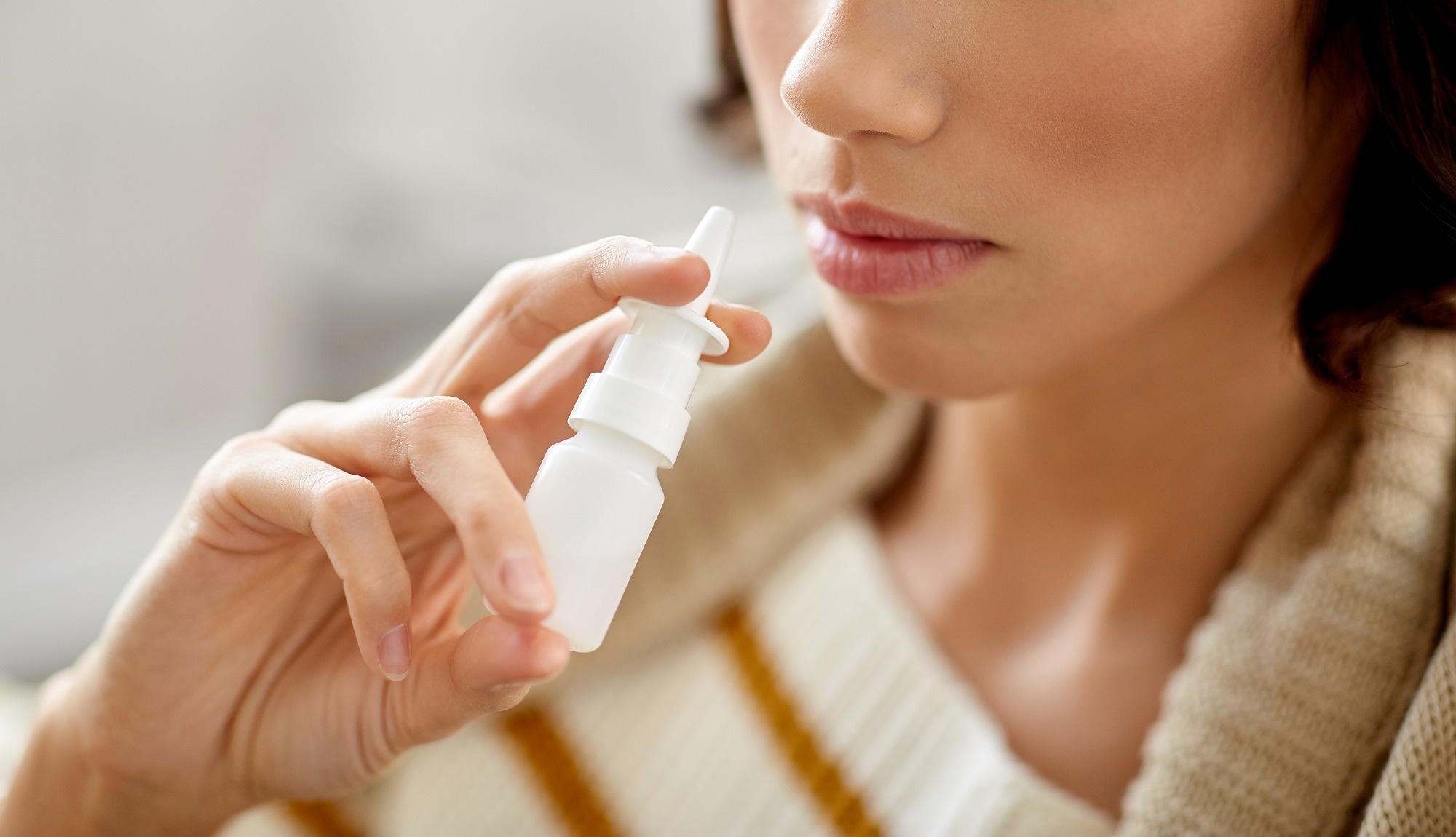An everyday allergy spray lowered coronavirus and cold infections in a clinical trial, sparking interest in its potential as a simple, over-the-counter defense against respiratory viruses.
 Study: Azelastine Nasal Spray for Prevention of SARS-CoV-2 Infections: A Phase 2 Randomized Clinical Trial. Image Credit: Ground Picture / Shutterstock.com
Study: Azelastine Nasal Spray for Prevention of SARS-CoV-2 Infections: A Phase 2 Randomized Clinical Trial. Image Credit: Ground Picture / Shutterstock.com
Despite widespread vaccination rates and established population immunity, the severe acute respiratory syndrome coronavirus 2 (SARS-CoV-2) continues to mutate and circulate throughout the environment. This emphasizes the critical need for effective prophylactic therapies, particularly for high-risk groups like the elderly and immunocompromised.
In a recent study published in the JAMA Internal Medicine, researchers determined the efficacy and safety of azelastine 0.1% nasal spray in a phase 2 double-blind, placebo-controlled randomized clinical trial for preventing SARS-CoV-2 infection in healthy adults.
Evaluating azelastine as prophylaxis against COVID-19
Azelastine is a histamine H1-receptor antagonist widely available as an over-the-counter nasal spray for managing allergies. Recent studies suggest that azelastine exhibits antiviral activity against respiratory syncytial virus (RSV) and influenza A (H1N1), with several randomized clinical trials confirming reductions in SARS-CoV-2 viral load when used to treat COVID-19.
In the current study, researchers conducted a double-blind, placebo-controlled randomized clinical trial at Saarland University Hospital to evaluate azelastine as a prophylactic measure against SARS-CoV-2. Healthy adults between 18 and 65 years of age with negative rapid antigen test (RAT) results were randomized to use either azelastine nasal spray or placebo three times every day for 56 days. If a high-risk exposure occurred or symptoms were detected, study participants were advised to increase their dose to five times/day for three days.
Twice-weekly nasopharyngeal RATs were performed, with all positive results confirmed by reverse-transcriptase polymerase chain reaction (RT-PCR) assay. Symptomatic participants with negative RAT results were also subsequently tested using RT-PCR assay and a multiplex respiratory panel for rhinovirus, influenza, endemic coronaviruses, RSV, human metapneumovirus (HMPV), adenovirus, and Mycoplasma pneumoniae, and other pathogens, including parainfluenza, bocavirus, enterovirus, and parechovirus.
The primary endpoint was PCR-confirmed SARS-CoV-2 infection throughout the study period. Secondary end points included symptomatic infection, time to infection, duration of RAT positivity, non-SARS-CoV-2 infections, and adverse events (AEs) coded with the Medical Dictionary for Regulatory Activities (MedDRA).
Secondary outcomes were not adjusted for multiplicity, and some sensitivity analyses lost statistical significance under certain imputations, though no scenario favored placebo. All analyses used intention-to-treat (ITT) and per-protocol (PP) sets with statistics and time-to-event models.
Clinical efficacy and safety results
A total of 450 participants were included in the study, 227 and 223 of whom were treated with azelastine or placebo, respectively. Throughout the study period, PCR-confirmed SARS-CoV-2 infection was reported in 2.2% of azelastine recipients as compared to 6.7% of those in the placebo group, with a risk difference (RD) of -4.5 percentage points and an odds ratio (OR) of 0.31.
The time-to-event analysis indicated that azelastine treatment reduced the hazard of infection (hazard ratio 0.31). Among infected participants, the mean time to infection was longer with azelastine than with placebo, at 31.2 and 19.5 days, respectively. Symptomatic SARS-CoV-2 infections were less frequent with azelastine, at 1.8%, as compared to placebo, at 6.3%.
The mean duration of RAT positivity was shorter with azelastine treatment at 3.40 days compared to 5.14 days among placebo recipients. Across all laboratory-confirmed respiratory infections, 8.4% of azelastine users tested positive compared to 18.8% of study participants in the placebo group.
Human rhinovirus was the most frequent non-SARS-CoV-2 pathogen to infect study participants. However, its incidence was lower with azelastine treatment than with placebo, at 1.8% and 6.3%, respectively. Reduced cumulative illness days were also lower throughout the study period.
About 52% of study participants reported at least one AE following azelastine treatment, compared to 50.7% with a placebo. Some of the different AEs associated with azelastine treatment included bitter taste, epistaxis, and fatigue, all known side effects of topical antihistamines.
Treatment discontinuation due to AEs were uncommon at 0.9% and 0.5% for azelastine and placebo, respectively. Two serious AEs were reported in the azelastine group, of which included recurrent headache that required hospital evaluation and new Hashimoto thyroiditis.
Potential sources of bias included reliance on RAT results to initiate further testing, missed detection of asymptomatic infection, and partial unblinding related to the bitter taste. Placebo hypromellose may have also led to minor barrier effects, which further dilutes between-group differences.
Clinical implications
Regular use of azelastine nasal spray was associated with fewer laboratory-confirmed SARS-CoV-2 infections and fewer overall respiratory infections. Importantly, these results were based on a single-center trial in mostly healthy and vaccinated adults with low event counts and measurement biases. Larger, multicenter studies are needed across diverse ages, risk profiles, and viral seasons to confirm effectiveness, refine optimal dosing schedules, and characterize benefits against other respiratory pathogens.
Journal reference:
- Lehr, T., Meiser, P., Selzer, D., et al. (2025). Azelastine Nasal Spray for Prevention of SARS-CoV-2 Infections: A Phase 2 Randomized Clinical Trial. JAMA Internal Medicine. doi:10.1001/jamainternmed.2025.4283